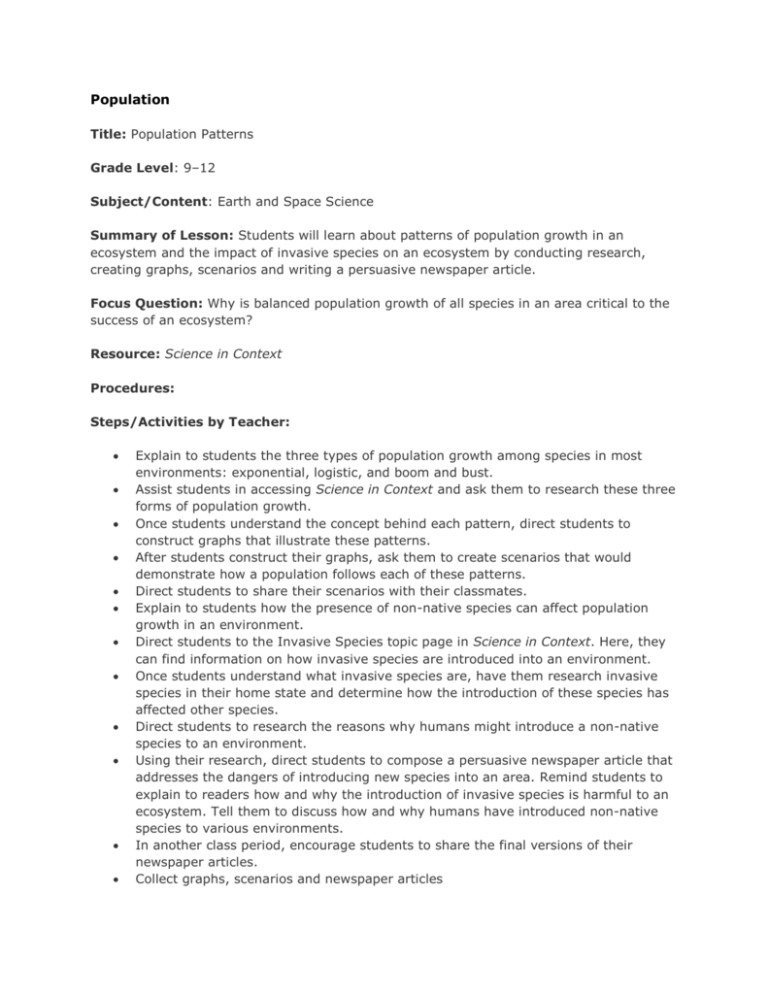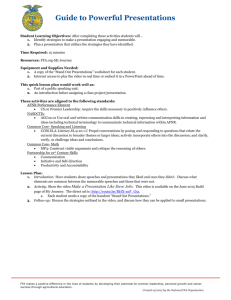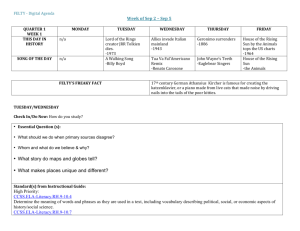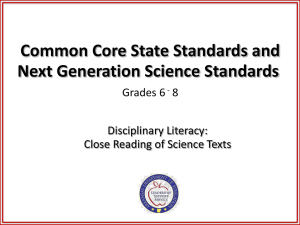Population Patterns
advertisement

Population Title: Population Patterns Grade Level: 9–12 Subject/Content: Earth and Space Science Summary of Lesson: Students will learn about patterns of population growth in an ecosystem and the impact of invasive species on an ecosystem by conducting research, creating graphs, scenarios and writing a persuasive newspaper article. Focus Question: Why is balanced population growth of all species in an area critical to the success of an ecosystem? Resource: Science in Context Procedures: Steps/Activities by Teacher: Explain to students the three types of population growth among species in most environments: exponential, logistic, and boom and bust. Assist students in accessing Science in Context and ask them to research these three forms of population growth. Once students understand the concept behind each pattern, direct students to construct graphs that illustrate these patterns. After students construct their graphs, ask them to create scenarios that would demonstrate how a population follows each of these patterns. Direct students to share their scenarios with their classmates. Explain to students how the presence of non-native species can affect population growth in an environment. Direct students to the Invasive Species topic page in Science in Context. Here, they can find information on how invasive species are introduced into an environment. Once students understand what invasive species are, have them research invasive species in their home state and determine how the introduction of these species has affected other species. Direct students to research the reasons why humans might introduce a non-native species to an environment. Using their research, direct students to compose a persuasive newspaper article that addresses the dangers of introducing new species into an area. Remind students to explain to readers how and why the introduction of invasive species is harmful to an ecosystem. Tell them to discuss how and why humans have introduced non-native species to various environments. In another class period, encourage students to share the final versions of their newspaper articles. Collect graphs, scenarios and newspaper articles Steps/Activities by Student(s): Access Science in Context to research the three types of population growth: exponential, logistic, and boom and bust. The following articles may help you gain a better understanding of these concepts: o "Population biology." Environmental Encyclopedia. Gale, 2011. Science in Context. o "Exponential growth." Environmental Encyclopedia. Gale, 2011. Science in Context. o "Logistic growth." Environmental Encyclopedia. Gale, 2011. Science in Context. Search Science in Context to locate more information about the three types of population patterns (exponential growth, logistic, boom and bust growth). Take note of other important terms that come up in your research. Once you understand the concept behind each type of population growth, construct graphs that illustrate each pattern. Create a scenario for each graph that demonstrates how a population follows this pattern. Share your completed scenarios with the rest of the class. Use Science in Context to access the Invasive Species topic page. During your search, try to find out how non-native species are introduced to an environment and why humans might introduce these species to a particular environment. Once you have a better understanding of invasive species, research invasive species in your home state. Try to determine how and why these species were introduced to your area. Using your research, compose a persuasive newspaper article about the dangers of introducing a new species into an area and the importance of preventing this type of introduction. Be sure to include an example of an invasive species and background information about population growth in your article. Remember to explain how and why this species became invasive and what impact it will have on the rest of the ecosystem. Submit your graphs, scenarios and newspaper article to your teacher Outcome: Students will be able to interpret basic population graphs and suggest scenarios about different population growth patterns in an ecosystem. Students will be able to construct a persuasive argument that outlines the impact an invasive species has on an area. Related Activities: Mathematics Provide students with data that breaks down a country’s or given area's population by the ratio of males to females or within particular age ranges. Students can then create a matrix and a histogram of thi s data. English/Language Arts Students create a fiction or nonfiction short story, poem, or play about an overpopulated world and the crisis that will/would arise. Students free write on the following prompt: Should humans be considered an invasive species? Global Studies Students construct population pyramids using population data. Examine population trends in different countries and examine the reason for the trends in certain areas. Encourage students to participate in a class discussion about worldwide human exponential growth and the impact it has on natural and economical resources. Learning Expectation: As a result of activities, students will be able to interpret population graphs and have an understanding of how humans impact population patterns and hence the success of many species within an ecosystem. Standards Alignment Next Generation Science Standards HS-LS1.CC.4.1. Feedback (negative or positive) can stabilize or destabilize a system. (HSLS1-3) HS-LS2-6. Evaluate the claims, evidence, and reasoning that the complex interactions in ecosystems maintain relatively consistent numbers and types of organisms in stable conditions, but changing conditions may result in a new ecosystem. HS-LS2-7. Design, evaluate, and refine a solution for reducing the impacts of human activities on the environment and biodiversity. LS2.A:1. Ecosystems have carrying capacities, which are limits to the numbers of organisms and populations they can support. These limits result from such factors as the availability of living and nonliving resources and from such challenges such as predation, competition, and disease. Organisms would have the capacity to produce populations of great size were it not for the fact that environments and resources are finite. This fundamental tension affects the abundance (number of individuals) of species in any given ecosystem. (HS-LS2-1), (HSLS2-2) LS2.C:1. A complex set of interactions within an ecosystem can keep its numbers and types of organisms relatively constant over long periods of time under stable conditions. If a modest biological or physical disturbance to an ecosystem occurs, it may return to its more or less original status (i.e., the ecosystem is resilient), as opposed to becoming a very different ecosystem. Extreme fluctuations in conditions or the size of any population, however, can challenge the functioning of ecosystems in terms of resources and habitat availability. (HS-LS2-2), (HS-LS2-6) LS2.C:2. Moreover, anthropogenic changes (induced by human activity) in the environment—including habitat destruction, pollution, introduction of invasive species, overexploitation, and climate change—can disrupt an ecosystem and threaten the survival of some species. (HS-LS2-7) LS4.D:2. Humans depend on the living world for the resources and other benefits provided by biodiversity. But human activity is also having adverse impacts on biodiversity through overpopulation, overexploitation, habitat destruction, pollution, introduction of invasive species, and climate change. Thus sustaining biodiversity so that ecosystem functioning and productivity are maintained is essential to supporting and enhancing life on Earth. Sustaining biodiversity also aids humanity by preserving landscapes of recreational or inspirational value. (secondary to HS-LS2-7) (Note: This Disciplinary Core Idea is also addressed by HS-LS4-6.) ETS1.B:1. When evaluating solutions it is important to take into account a range of constraints including cost, safety, reliability and aesthetics and to consider social, cultural and environmental impacts. (secondary to HS-LS2-7) HS-LS2.CC.5.1. Much of science deals with constructing explanations of how things change and how they remain stable. (HS-LS2-6), (HS-LS2-7) LS4.D:1. Humans depend on the living world for the resources and other benefits provided by biodiversity. But human activity is also having adverse impacts on biodiversity through overpopulation, overexploitation, habitat destruction, pollution, introduction of invasive species, and climate change. Thus sustaining biodiversity so that ecosystem functioning and productivity are maintained is essential to supporting and enhancing life on Earth. Sustaining biodiversity also aids humanity by preserving landscapes of recreational or inspirational value. (HS-LS4-6) (Note: This Disciplinary Core Idea is also addressed by HSLS2-7.) HS-ESS1.CC.4.1. Much of science deals with constructing explanations of how things change and how they remain stable. (HS-ESS1-6) HS-ESS2.CC.4.1. Much of science deals with constructing explanations of how things change and how they remain stable. (HS-ESS2-7) HS-ESS3.SEP.3.1. Construct an explanation based on valid and reliable evidence obtained from a variety of sources (including students’ own investigations, models, theories, simulations, peer review) and the assumption that theories and laws that describe the natural world operate today as they did in the past and will continue to do so in the future. (HS-ESS3-1) HS-ESS3.CC.3.2. Feedback (negative or positive) can stabilize or destabilize a system. (HSESS3-4) HS-ETS1-3. Evaluate a solution to a complex real-world problem based on prioritized criteria and trade-offs that account for a range of constraints, including cost, safety, reliability, and aesthetics, as well as possible social, cultural, and environmental impacts. HS-ESS2.CNS.1.3. Science includes the process of coordinating patterns of evidence with current theory. (HS-ESS2-3) Standards Source: Next Generation Science Standards (2013) Common Core State Standards Grades 9-10 CCSS.ELA-Literacy.RST.9-10.2 Determine the central ideas or conclusions of a text; trace the text's explanation or depiction of a complex process, phenomenon, or concept; provide an accurate summary of the text. CCSS.ELA-Literacy.RST.9-10.4 Determine the meaning of symbols, key terms, and other domain-specific words and phrases as they are used in a specific scientific or technical context relevant to grades 9-10 texts and topics. CCSS.ELA-Literacy.RST.9-10.5 Analyze the structure of the relationships among concepts in a text, including relationships among key terms (e.g., force, friction, reaction force, energy). CCSS.ELA-Literacy.RST.9-10.9 Compare and contrast findings presented in a text to those from other sources (including their own experiments), noting when the findings support or contradict previous explanations or accounts. CCSS.ELA-Literacy.RST.9-10.10 By the end of grade 10, read and comprehend science/technical texts in the grades 9-10 text complexity band independently and proficiently. CCSS.ELA-Literacy.WHST.9-10.4 Produce clear and coherent writing in which the development, organization, and style are appropriate to task, purpose, and audience. Grades 11-12 CCSS.ELA-Literacy.RST.11-12.2 Determine the central ideas or conclusions of a text; summarize complex concepts, processes, or information presented in a text by paraphrasing them in simpler but still accurate terms. CCSS.ELA-Literacy.RST.11-12.4 Determine the meaning of symbols, key terms, and other domain-specific words and phrases as they are used in a specific scientific or technical context relevant to grades 11-12 texts and topics. CCSS.ELA-Literacy.RST.11-12.5 Analyze how the text structures information or ideas into categories or hierarchies, demonstrating understanding of the information or ideas. CCSS.ELA-Literacy.RST.11-12.8 Evaluate the hypotheses, data, analysis, and conclusions in a science or technical text, verifying the data when possible and corroborating or challenging conclusions with other sources of information. CCSS.ELA-Literacy.RST.11-12.9 Synthesize information from a range of sources (e.g., texts, experiments, simulations) into a coherent understanding of a process, phenomenon, or concept, resolving conflicting information when possible. CCSS.ELA-Literacy.RST.11-12.10 By the end of grade 12, read and comprehend science/technical texts in the grades 11-12 text complexity band independently and proficiently. CCSS.ELA-Literacy.WHST.11-12.4 Produce clear and coherent writing in which the development, organization, and style are appropriate to task, purpose, and audience. Standards Source: Common Core State Standards Initiative (2010)








